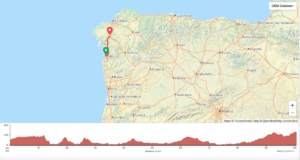About
Have you ever dreamed of walking the Camino de Santiago (The Way of Saint James), an ancient pilgrimage route through beautiful northern Spain?
Now is your chance! Join Fr. David Dufresne for a week on the Camino, from May 22 to May 29, 2022.
When: Sunday, May 22nd through Sunday, May 29th, 2022.
Goal: To engage in a spiritual pilgrimage, following in the footsteps of the ancient peregrinos (pilgrims) who walked across Spain to give homage to the tomb of St. James the Greater.
Important Dates:
- Informational Meeting: September 26th & October 10th, 3:30PM at the Basilica of Saint Mary’s Lyceum Auditorium (313 Duke Street)
- Watch “The Way”: February 19th, 6:30PM at the Basilica of Saint Mary’s Lyceum Auditorium (313 Duke Street)
- Applications due: March 25th
- Camino Dinner: April 26th
- Basilica to Basilica Camino (12 mi hike): Saturday, April 30th
- Packing Party: May 14th, 6:30PM at the Basilica of Saint Mary’s Lyceum Auditorium (313 Duke Street)
 History: The traditional pilgrimage route, called “the French Way,” extends 490 miles from France across northern Spain, to the city of Santiago de Compostela. The name of the city derives from “Sant Iago” or “Saint James,” and “Compostella” comes either from the Latin “Campus Stella” (meaning “Field of Stars”) or “Composita Tella” (“burial ground”).
History: The traditional pilgrimage route, called “the French Way,” extends 490 miles from France across northern Spain, to the city of Santiago de Compostela. The name of the city derives from “Sant Iago” or “Saint James,” and “Compostella” comes either from the Latin “Campus Stella” (meaning “Field of Stars”) or “Composita Tella” (“burial ground”).
The “Camino de Santiago” or “Way of St. James” has its origins in the missionary work of the Apostle St. James the Greater. According to oral history and both geographic and cultural evidence, St. James evangelized throughout the Iberian Peninsula. According to one legend, after he died, his body was placed on a boat, which landed off the Spanish coast near present-day Santiago. Another legend claims that a farmer found his body years later. In any case, when the remains were discovered, King Alfonso II of Asturias (then a kingdom in what is now most of northern Spain) ordered that a chapel be built to house them in what is now the city of Santiago de Compostela. Construction of the current cathedral began in 1075 under the reign of King Alfonso VI, on the site of the old church. It is well known for its main facade, the Gloria Portico, which depicts 200 figures involved in scenes from the Apocalypse, as well as St. James himself, welcoming pilgrims to their final destination. The church was consecrated in 1211.
As years past, and word spread throughout Europe that the body of an Apostle had been discovered, thousands of Christians descended from mainland Europe to the Iberian Peninsula using old Roman trade roads. To accommodate these pilgrims, bridges, hospitals and taverns or hostels were built along the route. The influx of so many Christian travelers truly changed history, helping Spanish forces raise recruits to fight back Muslim invaders from the south.
The cathedral in Santiago is home to the Botafumeiro, a gigantic censer that when manned swings 65 feet high across the transept at a top speed of 42 miles per hour, showering incense onto the congregation. The Botafumerio weighs 117 lbs. and is just under 5 feet tall. To use it, eight individuals called tiraboleiros pull up and down on ropes that help control the device. Tradition says the Botafumeiro was invented to treat the smell of thousands of pilgrims arriving in the cathedral after their long, arduous journeys.
To view a PowerPoint presentation on the trip, click here.
How to Prepare:
- Complete the online application below. The deadline to register is March 25th.
- Go on practice hikes, the first one being the 12-mile Basilica to Basilica Camino (April 30th).
- Start saving up money!
- Start praying! Attend Eucharistic Adoration whenever possible. The Basilica of Saint Mary offers Eucharistic Adoration every Wednesday, beginning after the 12:10pm Mass until Benediction at 8:30pm. Receive the Sacrament of Reconciliation on at least a monthly basis. Develop a devotion to St. James the Greater. Pray the rosary and Divine Mercy Chaplet. Fast for you and your fellow peregrinos.
Itinerary
We will be doing the last 100k of the Portuguese Route, please see tentative itinerary and map below.
- Day 1: Vigo à Redondela 16k
- Day 2: Redondela à Pontevedra 21k
- Day 3: Pontevedra à Armenteira 22k
- Day 4: Armenteira à Vilanova de Arousa 23k
- Day 5: Vilanova de Arousa à Padron 28k on a boat!
- Day 6: Padron à Santiago de Compostela 25k

More Information About Cost Coming Soon! But please note that participants are responsible for their own airfare and accommodations.
Please direct questions to Fr. David or Director of the Young Adult Apostolate, Mariane Staron, at [email protected].
